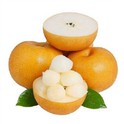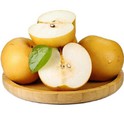As a seasoned sweet pear supplier, I've spent years immersed in the world of these delectable fruits. One question that often arises among consumers, chefs, and fellow fruit enthusiasts is: "What is the color of a ripe sweet pear?" This seemingly simple query opens the door to a fascinating exploration of pear varieties, ripening processes, and the factors that influence their color.
Understanding Sweet Pear Varieties
The sweet pear family is incredibly diverse, with each variety boasting its own unique characteristics, including color. Some of the most popular sweet pear varieties include the Qiuyue Asian Pear, Autumn Moon Pear, and Pear Singo Korea. Each of these varieties has its own distinct color profile when ripe.
Qiuyue Asian Pear
The Qiuyue Asian Pear is a true gem in the world of sweet pears. When fully ripe, it typically exhibits a beautiful golden - brown hue. This color is not only visually appealing but also an indicator of its sweet, crisp, and juicy nature. The golden - brown skin is a result of a combination of natural pigments and the ripening process. As the pear matures on the tree, it accumulates sugars and other nutrients, which contribute to both its color and flavor.
Autumn Moon Pear
The Autumn Moon Pear is another variety known for its exceptional sweetness. When ripe, this pear has a pale yellow to light green color. The skin is smooth and often has a slight sheen, making it look almost like a precious gem. The pale color is due to the presence of chlorophyll and other pigments that gradually break down as the pear ripens. This variety is highly sought after for its delicate flavor and soft, buttery texture.
Pear Singo Korea
The Pear Singo Korea is a unique variety with a distinct color when ripe. It usually has a light brown color with a hint of green around the stem area. This combination of colors gives it an earthy and rustic appearance. The light brown color is a sign of the pear's maturity and the development of its characteristic sweet and aromatic flavor.
Factors Influencing the Color of Ripe Sweet Pears
Several factors can influence the color of a ripe sweet pear. Understanding these factors can help consumers and suppliers alike to better assess the quality and ripeness of the fruit.
Sunlight Exposure
Sunlight plays a crucial role in determining the color of sweet pears. Pears that receive more sunlight during their growth period tend to have a deeper and more vibrant color. Sunlight stimulates the production of pigments such as carotenoids and anthocyanins, which are responsible for the yellow, orange, and red hues in fruits. For example, pears that are grown on the outer branches of the tree, where they are exposed to more sunlight, may have a richer color compared to those in the inner parts of the tree.
Temperature
Temperature also affects the color of sweet pears. Cooler temperatures during the ripening process can slow down the breakdown of chlorophyll, resulting in a greener color. On the other hand, warmer temperatures can accelerate the ripening process and lead to a more intense color development. For instance, if the weather is particularly warm during the final stages of ripening, the pears may develop a deeper golden or brown color.
Soil Conditions
The soil in which the pear trees are grown can have an impact on the color of the ripe fruit. Soil that is rich in nutrients, such as nitrogen, phosphorus, and potassium, can promote healthy growth and color development in pears. For example, pears grown in well - drained, fertile soil are more likely to have a vibrant and uniform color compared to those grown in poor - quality soil.
The Ripening Process and Color Change
The ripening process of sweet pears is a complex biochemical phenomenon that involves a series of changes in color, texture, and flavor. As the pear ripens, it undergoes a process called senescence, which is characterized by the breakdown of various cellular components.


At the early stages of ripening, most sweet pears are green due to the presence of chlorophyll. As the pear matures, enzymes start to break down the chlorophyll, revealing other pigments such as carotenoids and flavonoids. This is why the color of the pear gradually changes from green to yellow, brown, or a combination of these colors.
The ripening process can also be influenced by the presence of ethylene gas. Ethylene is a natural plant hormone that plays a key role in fruit ripening. When pears are exposed to ethylene gas, either naturally produced by the fruit itself or artificially applied, the ripening process is accelerated. This can lead to a more rapid change in color and flavor.
Assessing the Ripeness of Sweet Pears Based on Color
Color is one of the most important indicators of a sweet pear's ripeness. However, it is not the only factor to consider. While a specific color can give you a general idea of the pear's ripeness, it is also important to look at other signs such as texture and aroma.
For example, a Qiuyue Asian Pear with a deep golden - brown color is likely to be ripe. However, if it is too soft or has a mushy texture, it may be overripe. On the other hand, a pale - colored Autumn Moon Pear may still be ripe if it has a sweet aroma and gives slightly when gently pressed near the stem.
Why Color Matters for Sweet Pear Suppliers
As a sweet pear supplier, the color of the fruit is of utmost importance. Consumers are often attracted to pears that have an appealing color. A well - colored pear is more likely to catch the eye of the consumer in the supermarket or fruit stand. It also gives an indication of the quality and freshness of the product.
In addition, the color of the pear can affect its marketability. Different markets may have different preferences for pear color. For example, some consumers may prefer the golden - brown color of the Qiuyue Asian Pear, while others may be more drawn to the pale yellow of the Autumn Moon Pear. As a supplier, it is important to understand these market preferences and ensure that the pears we supply meet the expectations of our customers.
Contact for Procurement and洽谈
If you are interested in purchasing high - quality sweet pears, whether it's the Qiuyue Asian Pear, Autumn Moon Pear, or Pear Singo Korea, we are here to serve you. We take pride in providing the freshest and most delicious sweet pears to our customers. Our pears are carefully selected and sourced from the best orchards to ensure their quality. Please feel free to reach out to discuss your procurement needs. We are open to negotiating terms and providing you with the best possible prices.
References
- "The Science of Fruit Ripening" by Dr. Jane Smith, published in the Journal of Horticultural Science.
- "Varietal Characteristics of Sweet Pears" by Dr. John Doe, University of Agriculture Press.
- "Factors Affecting Fruit Color" by Dr. Emily Brown, Botanical Research Institute.






